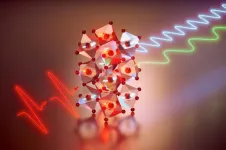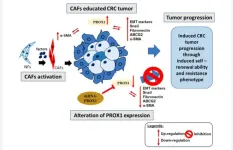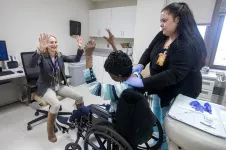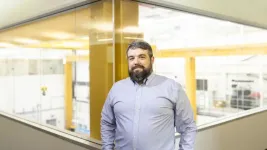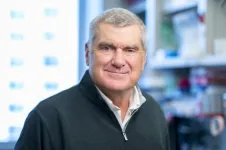(Press-News.org) One vision for the future of computing involves using ripples in magnetic fields — called magnons — as a basic mechanism. In this application, magnons would be comparable to electricity as the basis for electronics.
In conventional digital technologies, such magnonic systems are expected to be far faster than today’s technologies, from laptops and smartphones to telecommunications. In quantum computing, the advantages of magnonics could include not only quicker speeds but also more stable devices.
A recent study in the journal Nature Physics reports an early-stage discovery along the path to developing magnonic computers. The researchers caused two distinct types of ripples in the magnetic field of a thin plate of alloy, measured the results and showed that the magnons interacted in a nonlinear manner. “Nonlinear” refers to output that is not directly proportional to input — a necessity for any sort of computing application.
To date, most research in this area has focused on one type of magnon at a time, under relatively stable conditions described as equilibrium. Manipulating the magnons, as done in these studies, pushes the system out of equilibrium.
This is one of many investigations underway through a multiyear collaboration between theorists and experimentalists from multiple fields of science and engineering, including a second study that recently appeared in Nature Physics. The project, supported by government and private grantors, brings together researchers from UCLA, MIT, the University of Texas at Austin and the University of Tokyo in Japan.
“With our colleagues, we’ve started what I would call a campaign to spur progress in nonequilibrium physics,” said Prineha Narang, a co-author of the study and professor of physical sciences in UCLA College. “What we’ve done here fundamentally advances the understanding of nonequilibrium and nonlinear phenomena. And it could be a step toward computer memory using ultrafast phenomena that happen on the order of billionths of a second.”
One key technology behind these findings is an advanced technique for adding energy to and evaluating samples using lasers with frequencies in the terahertz range, which sits between the wavelengths of microwave and infrared radiation. Adopted from chemistry and medical imaging, the method is applied only rarely to study magnetic fields.
According to Narang, who is a member of the California NanoSystems Institute at UCLA, the use of terahertz lasers suggests potential synergy with a technology growing in maturity.
“Terahertz technology itself has reached the point where we can talk about a second technology that relies on it,” she said. “It makes sense to do this type of nonlinear control in a band where we have lasers and detectors that can be put on a chip. Now is the time to really push forward because we have both the technology and an interesting theoretical framework for looking at interactions among magnons.”
The researchers applied laser pulses to a 2-millimeter-thick plate made from a carefully chosen alloy containing yttrium, a metal found in LEDs and radar technology. In some experiments, a second terahertz laser was used in a coordinated way that paradoxically added energy but helped stabilize samples.
A magnetic field was applied to the yttrium in a specific fashion that allowed for only two types of magnon. The investigators were able to drive either type of magnon individually or both at the same time by rotating the sample to certain angles relative to the lasers. They were able to measure the interactions between the two types and found that they could cause nonlinear responses.
“Clearly demonstrating this nonlinear interaction would be important for any sort of application based on signal processing,” said co-author Jonathan Curtis, a UCLA postdoctoral researcher in the NarangLab. “Mixing signals like this could allow us to convert between different magnetic inputs and outputs, which is what you need for a device that relies on manipulating information magnetically.”
Narang said that trainees are vital to the current study, as well as the larger project.
“This is a really hard, multiyear endeavor with a lot of pieces,” she said. “What’s the right system and how do we go about working with it? How do we think about making predictions? How do we limit the system so it’s behaving as we want it to? We wouldn’t be able to do this without talented students and postdocs.”
The study includes MIT chemistry professor Keith Nelson and UT Austin physics professor Edoardo Baldini, along with the UCLA team led by Narang, which was supported by the Quantum Science Center, a Department of Energy National Quantum Information Science Research Center headquartered at Oak Ridge National Laboratory. The study was primarily supported by the Department of Energy as well as the Alexander von Humboldt Foundation, the Gordon and Betty Moore Foundation, the John Simon Guggenheim Memorial Foundation and the Japan Society for the Promotion of Science — all of which provide ongoing support for the collaboration.
END
Researchers measure and control interactions between magnetic ripples using lasers
Fundamental step toward ultrafast magnetism-based computers comes from multi-institution team involving UCLA
2024-02-07
ELSE PRESS RELEASES FROM THIS DATE:
Africa could grow more rice -- new study shows how
2024-02-07
Africa’s rice sector has major opportunities to increase its yield gains through improved agronomic practices while avoiding massive land conversion, a study by international scientists including a Husker co-investigator finds. The production advances can be important in meeting Africa’s projected food needs and reducing dependence on imports, the researchers concluded.
Rice demand in Africa is projected to more than double over the next 25 years due to population growth and increased rice consumption. At present, Africa imports nearly 40% of its rice.
“Nearly 15 million hectares of rice are waiting for yield improvement in Africa, ...
PROX1/α-SMA correlated with colorectal cancer progression, poor outcomes and therapeutic resistance
2024-02-07
“The findings validate the combined PROX1/α-SMA gene set as a prospective prognostic biomarker and a central regulator in CRC progression and its TME.”
BUFFALO, NY- February 7, 2024 – A new research paper was published in Aging (listed by MEDLINE/PubMed as "Aging (Albany NY)" and "Aging-US" by Web of Science) Volume 16, Issue 2, entitled, “PROX1 interaction with α-SMA-rich cancer-associated fibroblasts facilitates colorectal cancer progression and correlates with poor clinical outcomes and therapeutic resistance.”
The tumor microenvironment (TME) plays a vital role in tumor progression through intricate ...
Ancient rocks improve understanding of tectonic activity between earthquakes
2024-02-07
UNIVERSITY PARK, Pa. — Rocks once buried deep in ancient subduction zones — where tectonic plates collide — could help scientists make better predictions of how these zones behave during the years between major earthquakes, according to a research team from Penn State and Brown University.
Clues from rock formations in Alaska and Japan allowed the scientists to develop a new model to predict the pressure solution activity in subduction zones, the researchers reported in the journal Science Advances. ...
The Medical University of South Carolina will be one of four sites exploring the genetic basis of Parkinson’s disease in the Black community
2024-02-07
The Michael J. Fox Foundation for Parkinson’s Research has chosen MUSC as one of four sites for the Black and African American Connections to Parkinson’s Disease (BLAAC PD) research study, a part of the Global Parkinson’s Genetics Program.
BLAAC PD will explore the genetic basis of Parkinson’s disease (PD) in the Black community by genotyping more than 150,000 people worldwide, setting the stage for the development of targeted treatments. According to the Parkinson’s Foundation, approximately 36,265 people with ...
ORNL's Jason DeGraw named ASHRAE Fellow
2024-02-07
The American Society of Heating, Refrigeration and Air-Conditioning Engineers, or ASHRAE, selected Jason DeGraw, a researcher with the Department of Energy’s Oak Ridge National Laboratory, as one of 23 members elevated to Fellow during its 2024 winter conference.
A thermal-fluid scientist and mechanical engineer in the Thermal Energy Storage group, DeGraw was recognized for making substantial contributions in heating, ventilation, air-conditioning and refrigeration, and the built environment. He contributes education, research, engineering design and consultation, publications, presentations and mentoring to ASHRAE. At ORNL, DeGraw works with the Building Technologies ...
Sara Federico, MD, named director of the Solid Tumor Division at St. Jude Children’s Research Hospital
2024-02-07
(Memphis, Tenn. – February 7, 2024) St. Jude Children’s Research Hospital today announced Sara M. Federico, MD, has been named director of the institution’s Solid Tumor Division within the Department of Oncology. Federico is an internationally recognized leader in pediatric oncology whose contributions have defined the landscape of treatment for high-risk childhood solid tumors, such as neuroblastoma.
“Dr. Federico’s experience will pave the way for new discoveries that will help advance cure rates for patients with high-risk cancers by identifying, testing and optimizing novel therapeutic strategies,” said Julie R. ...
Cancer researcher Craig B. Thompson named 2024 Watanabe Prize winner
2024-02-07
INDIANAPOLIS – Pioneering cancer researcher Craig B. Thompson, MD, has been named the 2024 winner of the August M. Watanabe Prize in Translational Research.
Awarded by the Indiana University School of Medicine, the Watanabe Prize is one of the nation's largest and most prestigious awards recognizing individuals focused on shepherding scientific discoveries into new therapies for patients. The prize is awarded to a senior investigator who has made a significant contribution to the field of translational science.
Thompson is the former president and chief executive officer ...
Chapman scientists code ChatGPT to design new medicine
2024-02-07
Generative artificial intelligence platforms, from ChatGPT to Midjourney, grabbed headlines in 2023. But GenAI can do more than create collaged images and help write emails — it can also design new drugs to treat disease.
Today, scientists use advanced technology to design new synthetic drug compounds with the right properties and characteristics, also known as “de novo drug design.” However, current methods can be labor-, time-, and cost-intensive.
Inspired by ChatGPT’s popularity and wondering if this approach could speed up the drug design process, scientists in the Schmid ...
Erectile dysfunction drugs may be linked to reduced risk of Alzheimer’s disease
2024-02-07
EMBARGOED FOR RELEASE UNTIL 4 P.M. ET, WEDNESDAY, FEBRUARY 7, 2024
MINNEAPOLIS – The drugs used to treat erectile dysfunction may also be associated with a reduced risk of Alzheimer’s disease, according to a study published in the February 7, 2024, online issue of Neurology®, the medical journal of the American Academy of Neurology. The study does not prove that erectile dysfunction drugs reduce the risk of Alzheimer’s disease. It only shows an association.
Erectile dysfunction drugs, which work by dilating blood vessels to allow more blood ...
Q&A: Helping robots identify objects in cluttered spaces
2024-02-07
Imagine a coffee cup sitting on a table. Now, imagine a book partially obscuring the cup. As humans, we still know what the coffee cup is even though we can't see all of it. But a robot might be confused.
Robots in warehouses and even around our houses struggle to identify and pick up objects if they are too close together, or if a space is cluttered. This is because robots lack what psychologists call "object unity," or our ability to identify things even when we can't see all of them.
Researchers at the University of Washington ...
LAST 30 PRESS RELEASES:
How does age affect recovery from spinal cord injury?
Novel AI tool offers prognosis for patients with head and neck cancer
Fathers’ microplastic exposure tied to their children’s metabolic problems
Research validates laboratory model for studying high-grade serous ovarian cancer
SIR 2026 delivers transformative breakthroughs in minimally invasive medicine to improve patient care
Stem Cell Reports most downloaded papers of 2025 highlight the breadth and impact of stem cell research
Oxford-led study estimates NHS spends around 3% of its primary and secondary care budget on the health impacts of heat and cold in England
A researcher’s long quest leads to a smart composite breakthrough
Urban wild bees act as “microbial sensors” of city health.
New study finds where you live affects recovery after a hip fracture
Forecasting the impact of fully automated vehicle adoption on US road traffic injuries
Alcohol-related hospitalizations from 2016 to 2022
Semaglutide and hospitalizations in patients with obesity and established cardiovascular disease
Researchers ‘listen in’ to embryo-mother interactions during implantation using a culture system replicating the womb lining
How changing your diet could help save the world
How to make AI truly scalable and reliable for real-time traffic assignment?
Beyond fragmented markets: A new framework for efficient and stable ride-pooling
Can shape priors make road perception more reliable for autonomous driving?
AI tracks nearly 100 years of aging research, revealing key trends and gaps
Innovative techniques enable Italy’s first imaging of individual trapped atoms
KIER successfully develops Korea-made “calibration thermoelectric module” for measuring thermoelectric device performance
Diversifying US Midwest farming for stability and resilience
Emphasizing immigrants’ deservingness shifts attitudes
Japanese eels, climate change, and river temperature
Pusan National University researchers discover faster, smarter heat treatment for lightweight magnesium metals
China’s 2024 Gastroenterology Report: marked progress in endoscopy quality and disease management
Pusan National University researchers uncover scalable method for ultrahigh-resolution quantum dot displays
Researchers use robotics to find potential new antibiotic among hundreds of metal complexes
Gut bacteria changes at the earliest stages of inflammatory bowel disease
Scientists develop new way to “listen in” on the brain’s hidden language
[Press-News.org] Researchers measure and control interactions between magnetic ripples using lasersFundamental step toward ultrafast magnetism-based computers comes from multi-institution team involving UCLA
